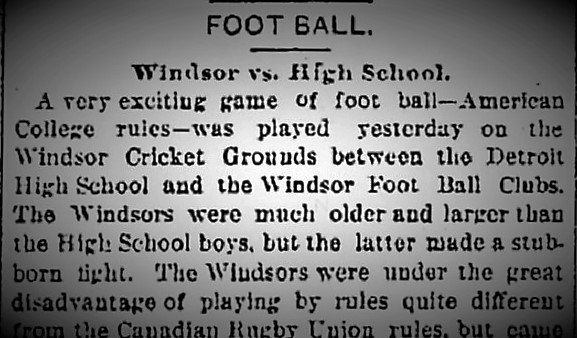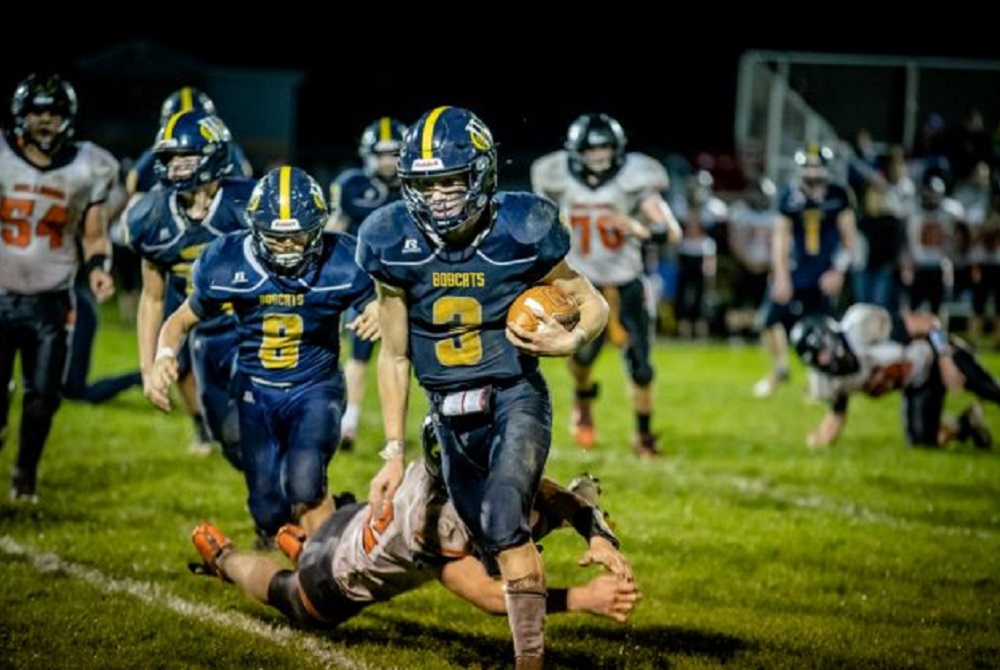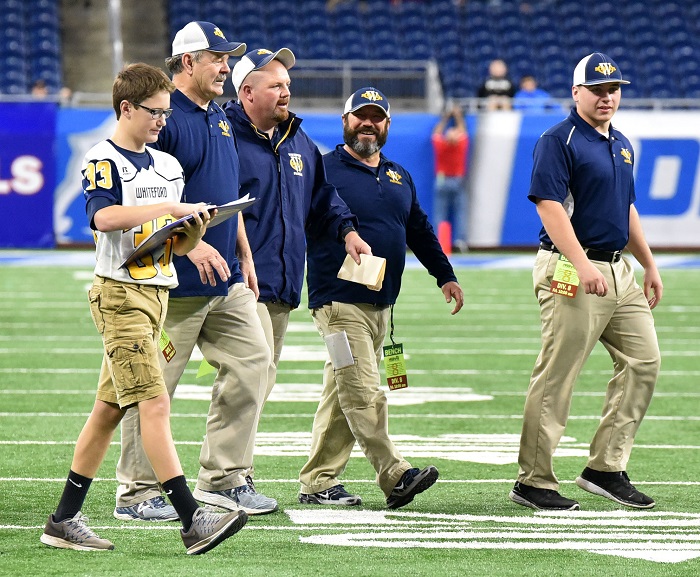
Football Kicks Off Again, 129 Years Later
August 25, 2017
By Ron Pesch
Special for Second Half
Buried in the text on the fourth page of the Saturday, October 27, 1888, Detroit Free Press is a single, concise sentence bearing a minimum amount of detail.
“The Windsor foot ball team will play the Detroit High School team this afternoon at 3.”
To date, this is the earliest account of a Michigan high school playing the game of “foot ball.”
The following day’s paper provides only a few more details. The game was played on the Windsor Cricket Grounds. Despite the great disadvantage of playing under “American Football rules … quite different from the Canadian Rugby Union rules …” the “older and larger” Windsors won the contest, 12-6. Rosters for each squad were provided.
 Under American rules of the time, a touchdown was worth four points, with a conversion kick following a touchdown worth two additional points. At the time, a field goal counted for five points and a safety was worth two. The teams, however, may have agreed to a different scoring system before the contest.
Under American rules of the time, a touchdown was worth four points, with a conversion kick following a touchdown worth two additional points. At the time, a field goal counted for five points and a safety was worth two. The teams, however, may have agreed to a different scoring system before the contest.
Was this the first football game for a Michigan high school? That’s unlikely, but it is certainly among the earliest published accounts involving a prep game in the state.
It’s a fair assumption that foot ball, or some version of the game, was being played in neighborhoods before that time, at least based on the following statement found in the Jackson Citizen Patriot, dated June 18, 1867. Only days before, Dorrance & Goodwin’s, a store on Main Street in Jackson, had placed advertisements in the newspaper’s classifieds noting the pending arrival of this new product.
“Foot Ball – The pastime was inaugurated on our streets yesterday. Three or four balls were kept in motion all day on Main street alone. It affords no little amusement to the little boys, and is certainly a healthy exercise for the larger ones. It’s all right as long as no windows are broken or horses scared. Both calamities were barely escaped scores of times during the day.”
Rutgers and Princeton are credited with playing the first college football game in 1869. A decade later, in 1879, the University of Michigan established a football team.
Detroit High School played a number of games in 1888, besides the Windsor match, including a contest with the Tappen School from the Corktown area of Detroit. Played at the Detroit Athletic Club grounds on the afternoon of Thursday November 15, a final score was not mentioned in the following day’s Free Press.
For those unfamiliar with the sport, an account of the University of Michigan versus Detroit Athletic Club contest that appeared in the November 18 Free Press served as a fine introduction to the game, and the determination behind securing “possession of a leather-covered foot ball.”
“It was very interesting to see one speedy young man, after a desperate struggle in which the spectators fully expected to see him lose an arm or a leg, get away from his captors and start like a deer, with eight or ten of the opposite side in full pursuit. He is overtaken and the leader of the pursuing party springs upon the back of the man with the inflated trophy, bearing him to the ground with a dull thud … It is also an inspiring sight to see a fleet-footed player seize the ball and run at full speed in the direction of the goal of his opponents. Then a wing-footed opponent cuts across to intercept him, makes a flying leap, grasps the fugitive around the neck or waist and both go to grass with a suddenness and velocity that transforms them into human wheels …
 “While one unaccustomed to foot ball will naturally be startled by some of the acrobatic feats, still it is impossible to watch the game for any length of time without a tingling of the blood and holding of the breath. It is most intensely exciting, continuous in action and replete with fine points of play.
“While one unaccustomed to foot ball will naturally be startled by some of the acrobatic feats, still it is impossible to watch the game for any length of time without a tingling of the blood and holding of the breath. It is most intensely exciting, continuous in action and replete with fine points of play.
“It may be explained that the goals in a foot ball game are set at a distance of 330 feet from each other. The goal is made by placing two pieces of scantling twenty feet long upright in the ground, eighteen and one-half feet apart. Another piece runs midway horizontally between the uprights, and the ball must go over the horizontal piece and between the uprights to count a goal. There are eleven men on each side and the object is, of course, to get the ball through the goal of the other. The time of game is an hour and a half each side playing forty-five minutes from each goal, with an intermission of ten minutes between halves.”
A player who ran over an opponent’s goal line, “with the ball and touched it down” was then entitled to “bring the ball in front of the goal and attempt to kick it through”…
Among those playing for the Athletic Club squad that day was “little Hugh Brooks (captain) of the high school team.” Eligibility rules for players would evolve over time.
On Saturday, November 24, Detroit High School squared off for the first of two contests with Ann Arbor High School, this one at the Detroit Athletic Club grounds. Admission to the 2:45 p.m. contests was 25 cents. A crowd of around 300 watched “an exciting illustration of how Rugby foot ball is played. The exhibition by the Ann Arbor boys was considerably better than that of the Detroiters,” noted the Free Press, “the result of that being that Detroit’s banners have been kicked into the dust.”
Ann Arbor returned home with a 12-0 victory.
A second game with Ann Arbor was quickly scheduled.
In between, on Thursday, November 29, the Detroit High School squad played the Athletic Club before a crowd of about 200.
 “While the Athletics won by 12 to 0, still their playing was very loose, probably the result of over confidence. The Athletics will have to rid themselves of this by Saturday or the Albions will make short work of them.”
“While the Athletics won by 12 to 0, still their playing was very loose, probably the result of over confidence. The Athletics will have to rid themselves of this by Saturday or the Albions will make short work of them.”
A large crowd gathered in the drizzling rain in Ann Arbor on Saturday, December 8, for what appears to be the final contest of the 1888 season for the high school teams of Detroit and Ann Arbor.
“It was a fine game. (Captain) Brooks, McGraw and Wisner, for Detroit, and Jewett, Diggert, Dupont, and Rathbone for Ann Arbor, made fine plays for their respective sides.” The result was an 8 to 2 win, and redemption, for the Detroit squad.
Today, 129 years later, “football” has seen wild expansion, numerous rule changes, and huge advancement in equipment worn when compared to those pioneer days of the sport. In 2017, more than 1 million individuals will suit up for high school teams across the United States. In Michigan alone, more than 36,000 participate in prep football.
And our state’s original programs live on. On Friday, Detroit Central opened its season with a win over Detroit Loyola. Ann Arbor High School, renamed Ann Arbor Pioneer in the late 1960s, fell in its Friday opener to Muskegon.
Welcome to another season of America’s favorite pastime.
 Ron Pesch has taken an active role in researching the history of MHSAA events since 1985 and began writing for MHSAA Finals programs in 1986, adding additional features and "flashbacks" in 1992. He inherited the title of MHSAA historian from the late Dick Kishpaugh following the 1993-94 school year, and resides in Muskegon. Contact him at [email protected] with ideas for historical articles.
Ron Pesch has taken an active role in researching the history of MHSAA events since 1985 and began writing for MHSAA Finals programs in 1986, adding additional features and "flashbacks" in 1992. He inherited the title of MHSAA historian from the late Dick Kishpaugh following the 1993-94 school year, and resides in Muskegon. Contact him at [email protected] with ideas for historical articles.
PHOTOS: (Top) The Detroit Free Press included brief coverage of the first "reported" game on Oct. 28, 1888. (Middle) When Michigan’s state government moved from Detroit to Lansing in 1847, the old Capitol building was re-opened as the Detroit’s first city high school in 1863. To better accommodate Detroit’s growing population, the old two-story structure was remodeled into a four-story building, unrecognizable to most. The school served the city well until January 1893, when it burned to the ground. (Below) Erected in 1856 at the cost of $27,000, Ann Arbor High School at State and Huron (now site of the North Quad of the University of Michigan) was destroyed by fire in 1904. (Photos courtesy of Ron Pesch.)

After Growing Up in Program, Giesige Earns Place Among Whiteford Greats
By
Doug Donnelly
Special for MHSAA.com
October 26, 2021
Cole Giesige had a big smile on his face when he went into the Ottawa Lake Whiteford huddle during the fourth quarter of Friday night’s win at Erie Mason.
 Giesige normally is a running back for the Bobcats, but he is also the backup quarterback for the team. When Whiteford built a big lead Friday to clinch the outright Tri-County Conference championship, Whiteford head coach Jason Mensing inserted Giesige at quarterback.
Giesige normally is a running back for the Bobcats, but he is also the backup quarterback for the team. When Whiteford built a big lead Friday to clinch the outright Tri-County Conference championship, Whiteford head coach Jason Mensing inserted Giesige at quarterback.
On the first play, Mensing called Giesige’s number. He then put his arm around the 6-foot-1 senior and called the play.
“He said, ‘You are two yards away from 1,000. Do you want to get it on this play?’ Giesige recalled. “I said, ‘Yeah.’ I was smiling when I went into the huddle.”
Giesige kept the ball and sliced his way through the Erie Mason defensive line for a six-yard gain. Goal accomplished. It was his final carry of the game, but it was a big one. It gave him 1,004 yards for the season.
“The line said, ‘All right, we’re going to get this for you’ and they did,” Giesige said. “I knew I had 909 coming into the game, but I didn’t know where I was at that point. When coach told me, I just started to smile.”
Reaching 1,000 yards has been a goal for Giesige since he was summoned to the varsity his sophomore season.
“That was one thing I set out to do,” Giesige said. “When I was a sophomore and I knew I was going to be on the varsity, I put goals on my walls, and one of them was 1,000 yards in a season. I’m glad I was finally able to accomplish that.”
Mensing said that after a big JV season as a freshman, Giesige was destined to be a big part of the Whiteford football team for the next three seasons.
“He’s a great kid,” Mensing said. “We knew when he was a sophomore and we brought him up that we were going to be relying on him to make big plays. He’s done a nice job.”
On Friday, Whiteford finished the regular season with an 8-1 record and No. 2 in playoff points in Division 8. The Bobcats are among favorites to make a deep run in the playoffs.
 Giesige was in eighth grade when the Bobcats made its best-ever playoff run – winning the 2017 Division 8 championship. Giesige played middle school football for the Bobcats that season, but served a role for the varsity as well – he was on the Whiteford sideline for the Final at Ford Field, charting defensive plays for the coaching staff.
Giesige was in eighth grade when the Bobcats made its best-ever playoff run – winning the 2017 Division 8 championship. Giesige played middle school football for the Bobcats that season, but served a role for the varsity as well – he was on the Whiteford sideline for the Final at Ford Field, charting defensive plays for the coaching staff.
“He’s been a part of the program for a long time,” Mensing said.
The son of Troy and Kim Giesige is also an accomplished baseball and basketball player at Whiteford. He was an all-state pitcher last year for the Bobcats baseball team that reached the Quarterfinals, and he is fielding offers to play the sport after high school. He led the Whiteford basketball team in scoring last winter.
“He is a competitor that has a passion to improve at his craft daily,” Mensing said. “He has high expectations for himself and those around him.”
It’s been an outstanding football season for Giesige. He has done a little bit of everything for the Bobcats.
Heading into Friday’s playoff opener, he has scored 25 touchdowns and converted nine two-point conversions for 168 points. He’s rushed for 18 touchdowns, caught four touchdown passes, returned two kickoffs for scores, and went 100 yards on an interception return in Week 8 against Petersburg Summerfield.
He now holds the record for longest kickoff return (95 yards) and longest interception return (100 yards) in school history. He’s moving up the charts in season and career touchdowns. He averages 9.3 yards per carry and nearly 23 yards per reception. His kickoff return average is 40 yards per attempt.
Mensing said scoring touchdowns isn’t all that he does.
“He is a solid blocker, a good ball catcher and obviously a back with good vision and ability to cut,” the 10th-year Whiteford coach said.
Whiteford has been on a roll of late. The Bobcats enter the postseason on a five-game winning streak and are averaging 52 points per game. During the win streak, they have scored 58, 54, 76, 46 and 62 points.
Giesige is one of just five seniors on the team, but they all play important roles. Two-way tackle Noah Bauman is a two-time all-stater and makes an impact on both sides of the ball. Jack Andrews was a center as a sophomore but was converted to tight end and he has caught four touchdowns this season. Ty Ruddy is a team leader and two-way starter, and linebacker Levi Hillard is among the team’s top tacklers.
Thanks to that core group, the Bobcats are primed and ready to make noise in the playoffs.
“I’m not really certain how it compares to years past as each team and journey is so unique,” Mensing said. “I do know we have a great group of guys that I think want to keep competing together a little longer.”
 Doug Donnelly has served as a sports and news reporter and city editor over 25 years, writing for the Daily Chief-Union in Upper Sandusky, Ohio from 1992-1995, the Monroe Evening News from 1995-2012 and the Adrian Daily Telegram since 2013. He's also written a book on high school basketball in Monroe County and compiles record books for various schools in southeast Michigan. E-mail him at [email protected] with story ideas for Jackson, Washtenaw, Hillsdale, Lenawee and Monroe counties.
Doug Donnelly has served as a sports and news reporter and city editor over 25 years, writing for the Daily Chief-Union in Upper Sandusky, Ohio from 1992-1995, the Monroe Evening News from 1995-2012 and the Adrian Daily Telegram since 2013. He's also written a book on high school basketball in Monroe County and compiles record books for various schools in southeast Michigan. E-mail him at [email protected] with story ideas for Jackson, Washtenaw, Hillsdale, Lenawee and Monroe counties.
PHOTOS (Top) Ottawa Lake Whiteford’s Cole Giesige runs the ball during a win over Petersburg Summerfield this season. (Middle) Giesige (far left) walks with the coaching staff during halftime of Whiteford’s 2017 Division 8 Final at Ford Field. (Top photo by Natalie McCormack; middle photo by Cari Hayes.)

